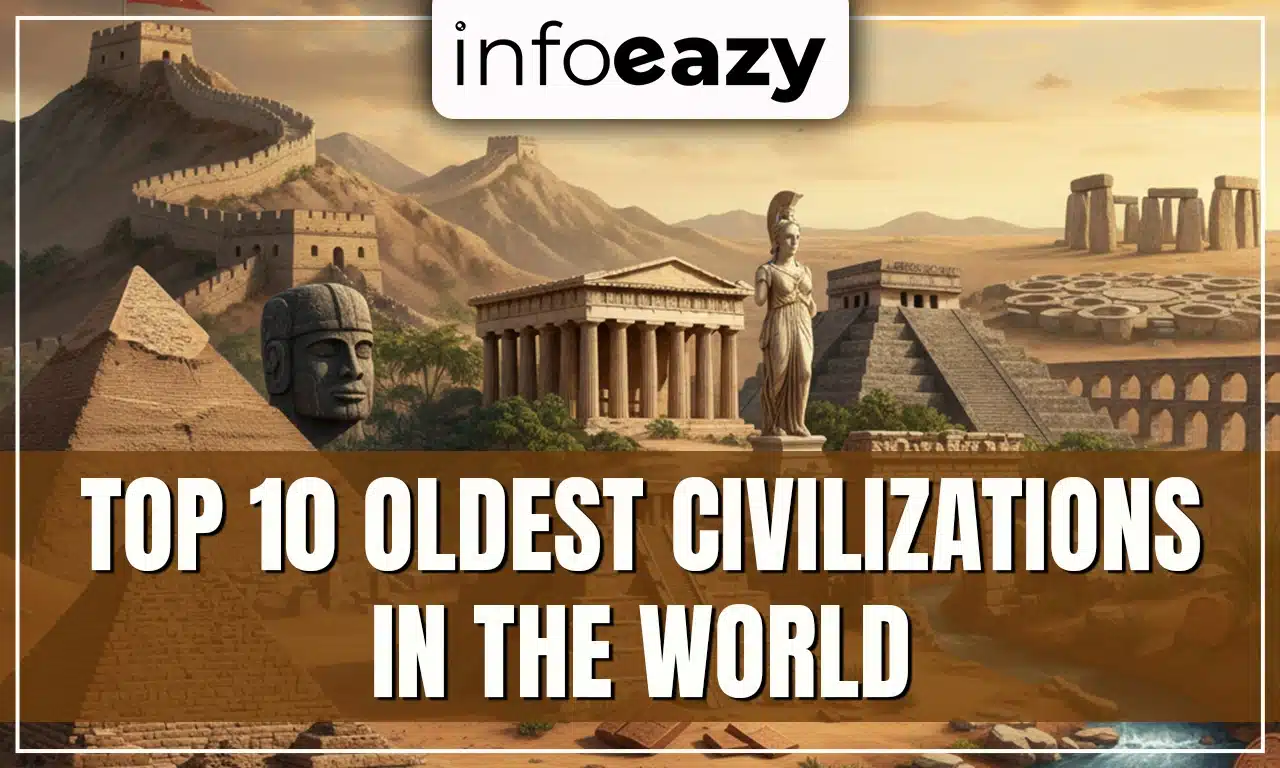Human history is marked by the rise and fall of civilizations that have shaped our world. From the fertile crescent of Mesopotamia to the ancient cities of the Indus Valley, these civilizations laid the foundation for modern society. In this article, we explore the Top 10 Oldest Civilizations in the World, highlighting their contributions and enduring legacies.
Top 10 Oldest Civilizations in the World
Human history has been shaped by ancient civilizations that laid the foundations of culture, governance, and technology. These civilizations emerged thousands of years ago and left enduring legacies that still influence modern society.
| Top 10 Oldest Civilizations in the World | ||||
| S.No | Civilization Name | Approximate Time Period | Region / Modern Country | Key Contributions |
| 1 | Sumerian | c. 4500 BCE | Iraq | Cuneiform writing, wheel, ziggurats, city-states |
| 2 | Caral-Supe | c. 3500 BCE | Peru | Pyramids, urban centers, agriculture, trade |
| 3 | Ancient Egyptian | c. 3150 BCE | Egypt | Pyramids, hieroglyphs, medicine, centralized rule |
| 4 | Indus Valley | c. 3300 BCE | Pakistan / NW India | Urban planning, drainage systems, trade |
| 5 | Ancient Chinese | c. 2070 BCE | China | Writing, paper, compass, dynastic rule |
| 6 | Ancient Israeli | c. 2000 BCE | Israel / Levant | Monotheism, Torah, laws, religious centers |
| 7 | Olmec | c. 1200 BCE | Mexico | Colossal heads, calendar, ceremonial centers |
| 8 | Ancient Greek | c. 1600 BCE | Greece | Democracy, philosophy, architecture, literature |
| 9 | Roman | 753 BCE | Italy / Europe | Law, roads, aqueducts, empire governance |
| 10 | Mayan | c. 2000 BCE | Mexico / Guatemala / Belize | Calendar, astronomy, pyramids, city-states |
1. Sumerian Civilization (c. 4500 BCE)
The Sumerians, residing in present-day Iraq, are credited with establishing the first true civilization. They introduced cuneiform writing, creating the earliest known form of written expression. Their innovations include the wheel, advanced irrigation techniques, and monumental architecture like ziggurats.
Key Contributions:
- Development of cuneiform writing
- Invention of the wheel and plow
- Establishment of city-states like Uruk and Ur
- Creation of legal codes and administrative systems
2. Caral-Supe Civilization (c. 3500 BCE)
Located in present-day Peru, the Caral-Supe civilization is among the oldest in the Americas. They built large urban centers with pyramids and complex social structures. Their society was based on agriculture, fishing, and trade, with no evidence of warfare.
Key Contributions:
- Construction of monumental pyramids and plazas
- Development of a complex social hierarchy
- Advanced agricultural practices
- Trade networks spanning the Andean region
3. Ancient Egyptian Civilization (c. 3150 BCE)
Flourishing along the Nile River, ancient Egypt is renowned for its monumental architecture, including the pyramids and the Sphinx. They developed hieroglyphic writing and made significant advances in mathematics, medicine, and engineering.
Key Contributions:
- Construction of the pyramids and temples
- Development of hieroglyphic writing
- Advancements in medicine and surgery
- Establishment of a centralized government under pharaohs
4. Indus Valley Civilization (c. 3300 BCE)
Spanning present-day Pakistan and northwest India, the Indus Valley Civilization was one of the world’s earliest urban cultures. Cities like Harappa and Mohenjo-Daro featured advanced drainage systems and standardized brick sizes. Their script remains undeciphered, adding to the mystery of their society.
Key Contributions:
- Urban planning with grid layouts
- Advanced drainage and sewage systems
- Standardized weights and measures
- Extensive trade networks with Mesopotamia
5. Ancient Chinese Civilization (c. 2070 BCE)
The Xia Dynasty marks the beginning of recorded Chinese history. Located along the Yellow River, ancient China developed a centralized bureaucracy, Confucian philosophy, and significant technological innovations like papermaking and the compass.
Key Contributions:
- Development of written characters and oracle bone script
- Invention of paper, gunpowder, and the compass
- Establishment of dynastic rule and bureaucracy
- Promotion of Confucian and Taoist philosophies
6. Ancient Israeli Civilization (c. 2000 BCE)
Emerging in the Levant region, the ancient Israeli civilization is foundational to Jewish, Christian, and Islamic traditions. They developed monotheistic beliefs, codified laws, and a rich literary tradition, including texts like the Torah.
Key Contributions:
- Development of monotheistic religion
- Codification of laws and ethical codes
- Creation of religious texts such as the Torah
- Establishment of Jerusalem as a religious center
7. Olmec Civilization (c. 1200 BCE)
The Olmecs, located in present-day Mexico, are considered the “mother culture” of Mesoamerica. They are known for creating colossal stone heads and laying the groundwork for future civilizations like the Maya and Aztec.
Key Contributions:
Creation of colossal stone heads
Development of a calendar system
Influence on later Mesoamerican cultures
Establishment of ceremonial centers like La Venta
8. Ancient Greek Civilization (c. 1600 BCE)
Ancient Greece is celebrated for its contributions to philosophy, democracy, and the arts. City-states like Athens and Sparta were centers of intellectual and political activity, producing thinkers like Socrates, Plato, and Aristotle.
Key Contributions:
- Development of democratic governance (Athens)
- Advancements in philosophy and science
- Creation of architectural styles like Doric and Ionic
- Production of epic literature such as the Iliad and Odysse
9. Roman Civilization (753 BCE)
Originating from the city of Rome, the Roman civilization expanded across Europe, North Africa, and the Middle East. They developed a legal system, extensive road networks, and monumental architecture, leaving a lasting legacy on Western civilization.
Key Contributions:
- Development of Roman law and legal principles
- Construction of roads, aqueducts, and amphitheaters
- Establishment of a republican and later imperial government
- Promotion of Latin language and literature
10. Mayan Civilization (c. 2000 BCE)
The Maya civilization flourished in present-day Mexico, Guatemala, and Belize. They developed an intricate calendar system, advanced mathematics, and monumental architecture, including the iconic step pyramids.
Key Contributions:
- Development of the Maya calendar and hieroglyphic writing
- Advancements in mathematics and astronomy
- Construction of step pyramids and ceremonial centers
- Establishment of city-states like Tikal and Palenque
Top 10 Oldest Civilizations in the World FAQs
Q1. What is considered the oldest civilization in the world?+
Q2. Which civilization is the oldest in the Americas?+
Q3. What are the main contributions of the Indus Valley Civilization?+
Q4. Which civilization developed the first writing system?+
Q5. Which ancient civilization is known for pyramids?+




